Homeostasis: Osmoregulation & Excretion [ZOOL 110, Exam 2]
1/43
There's no tags or description
Looks like no tags are added yet.
Name | Mastery | Learn | Test | Matching | Spaced |
|---|
No study sessions yet.
44 Terms
homeostasis
process by which organisms maintain a stable internal environment despite external fluctuations
thermoregulation
the maintenance of body temperature within a range that enables cells to function efficiently
osmoregulation
regulation of solute concentrations and water balance by a cell or organism
excretion
the process by which wastes are removed from the body
osmotic conformers
organisms that tolerate salinity variations without serious damage by remaining isosmotic with the water around them; match the salinity of surrounding water (ex: brackish environment)
hyperosmotic regulators
an aquatic animal that maintains a stable blood osmotic pressure higher than the osmotic pressure of the water in which it lives
euryhaline
organisms that can survive large fluctuations in external osmolarity
stenohaline
organisms with a limited ability to withstand osmotic changes in environment
brackish water
water with a level of salinity between freshwater and seawater
a blue crab (body fluid salinity = 550mM) placed in brackish (300mM) seawater will passively:
(a) gain salts, gain water
(b) lose salts, lose water
(c) gain salts, lose water
(d) lose salts, gain water
(d) lose salts, gain water
because the blue crab's internal salinity (550mM) is higher than the environmental salinity (300mM) it will lose salt and gain water to become isotonic with environment
isoosmotic
having the same total solute concentration
hypoosmotic
lower solute concentration
hyperosmotic
greater concentration of solutes
green gland (antennal gland)
an osmoregulatory organ that removes excess water from the body; found in brackish water invertebrates as a solution to passive salt loss/water gain
salt-secreting glands
glands found in gills that actively transport salt from environment into the body; found in brackish water invertebrates as a solution to passive salt loss and water gain
what are the osmoregulatory challenges faced by modern freshwater fishes?
challenge: salts are passively lost & water is passively gained.
reason: while the earliest fishes were marine, there is evidence the earliest bony fishes lived in freshwater. as a result, freshwater bony fishes evolved a more dilute body fluid concentration (~180mM)
osmoregulation solutions in modern freshwater fishes (hypoosmotic to saltwater)
- excess water pumped out by kidney as a dilute urine
- salt-absorbing cells move salts from water into blood
- prevent water gain through body surface by covering body with scales and mucous
a marine bony fish (~180mM) in seawater (550mM) will:
(a) gain salts, lose water
(b) lose salts, lose water
(c) gain salts, lose water
(d) lose salts, gain water
(c) gain salts, lose water
what are the osmoregulatory challenges faced by modern saltwater fishes?
challenge: water loss, salt gain
reason: many evolved from freshwater ancestors that re-invaded the sea, so modern marine bony fishes have body fluid salinites 1/3 of sewater (~180mM)
osmoregulation solutions in modern saltwater fishes (hypoosmotic to seawater)
- drink seawater
- absorb water and salt from intestine into bloodstream
- NaCl is carried by blood to gills, where it is actively transported out of the body by specialized cells
- kidney excretes a very concentrated urine
hypoosmotic regulators
organisms that maintain their body fluids at a lower concentration than their seawater environment
how do terrestrial animals lose water?
evaporation (from respiratory surfaces & body surface), excretion of urine, elimination of feces
how do terrestrial animals recover water?
drinking water, harvesting water vapor from air, free water in food, metabolic water formed in cells
metabolic water
water generated in the tissues during metabolism via oxidation of stored carbohydrates and fat
how do terrestrial animals minimize water loss?
produce concentrated urine, produce dry feces, convert nitrogenous waste to urea or uric acid
nitrogenous wastes
byproducts of the cellular conversion of amino acids into energy (urea, uric acid)
ammonia (NH3)
primary nitrogenous waste product in most aquatic animals, highly soluble in water
can be flushed from body when enough water is available or converted into urea/uric acid when water conservation is an issue
urea
primary nitrogenous waste excreted in urine of mammals/amphbians; less water is needed to remove it, but requires some energy to be converted
uric acid
one of the nitrogenous wastes excreted in the urine; the primary waste of birds, terrestrial reptiles, insects, and snails; more complex & requires a lot of energy to produce; insoluble in water
Bowman's capsule
cup-shaped structure of the nephron of a kidney which encloses the glomerulus and in which filtration takes place
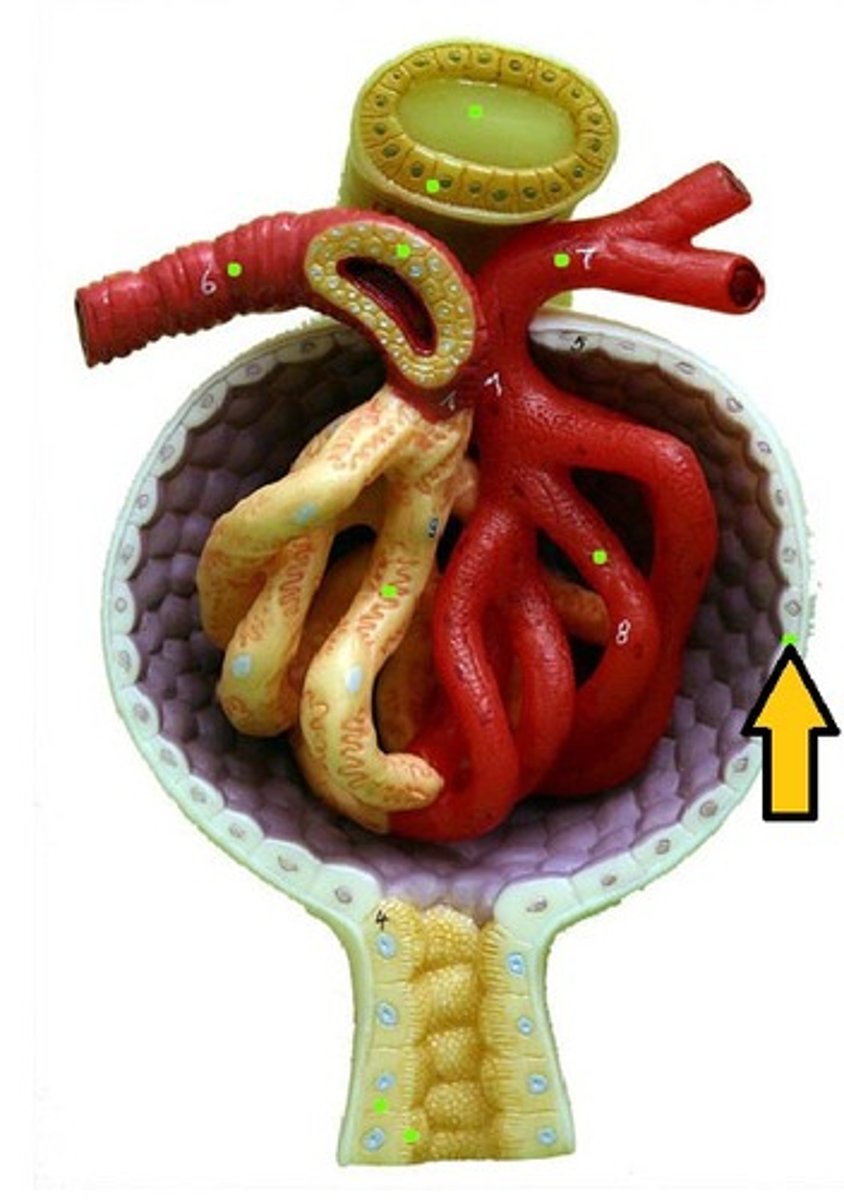
collecting duct
a segment of the nephron that returns water from the filtrate to the bloodstream; after the DCT
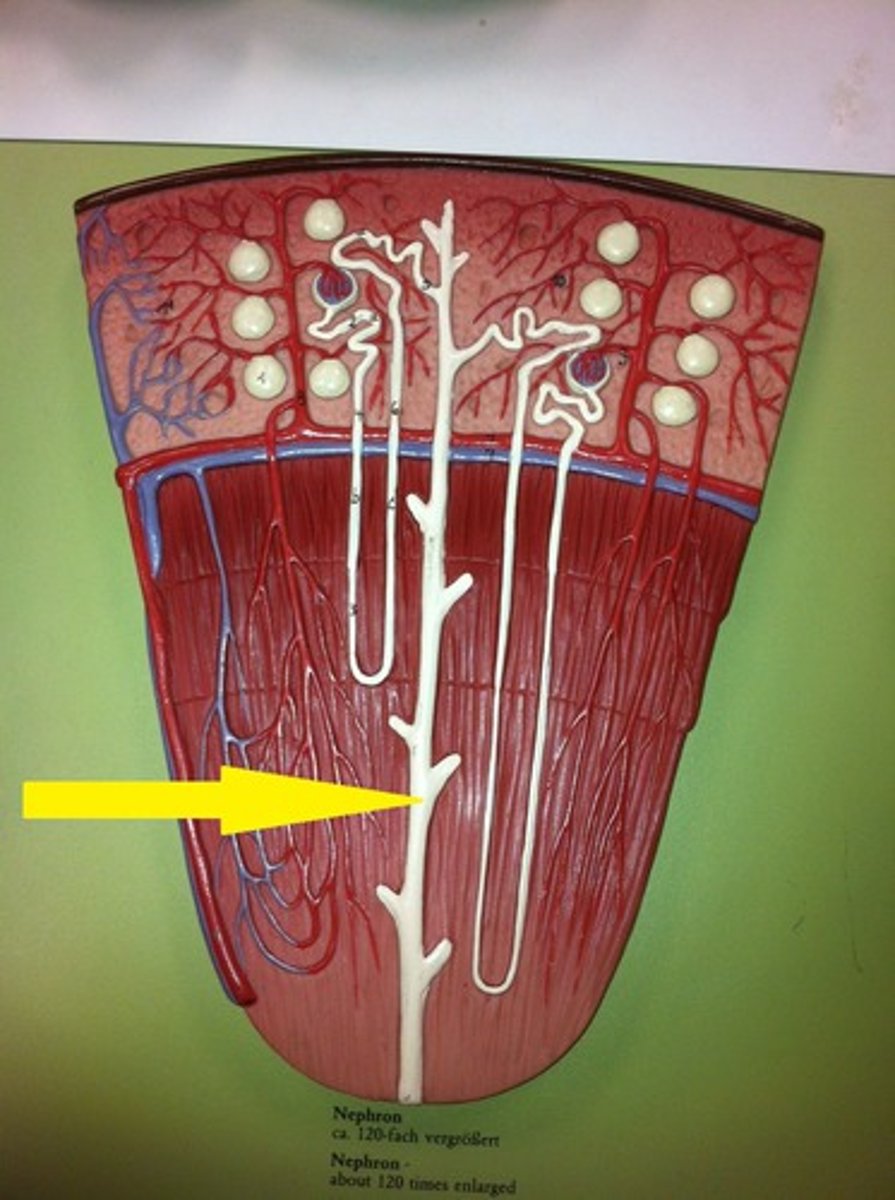
distal convoluted tubule (DCT)
a portion of kidney nephron after the loop of Henle and before the collecting duct system
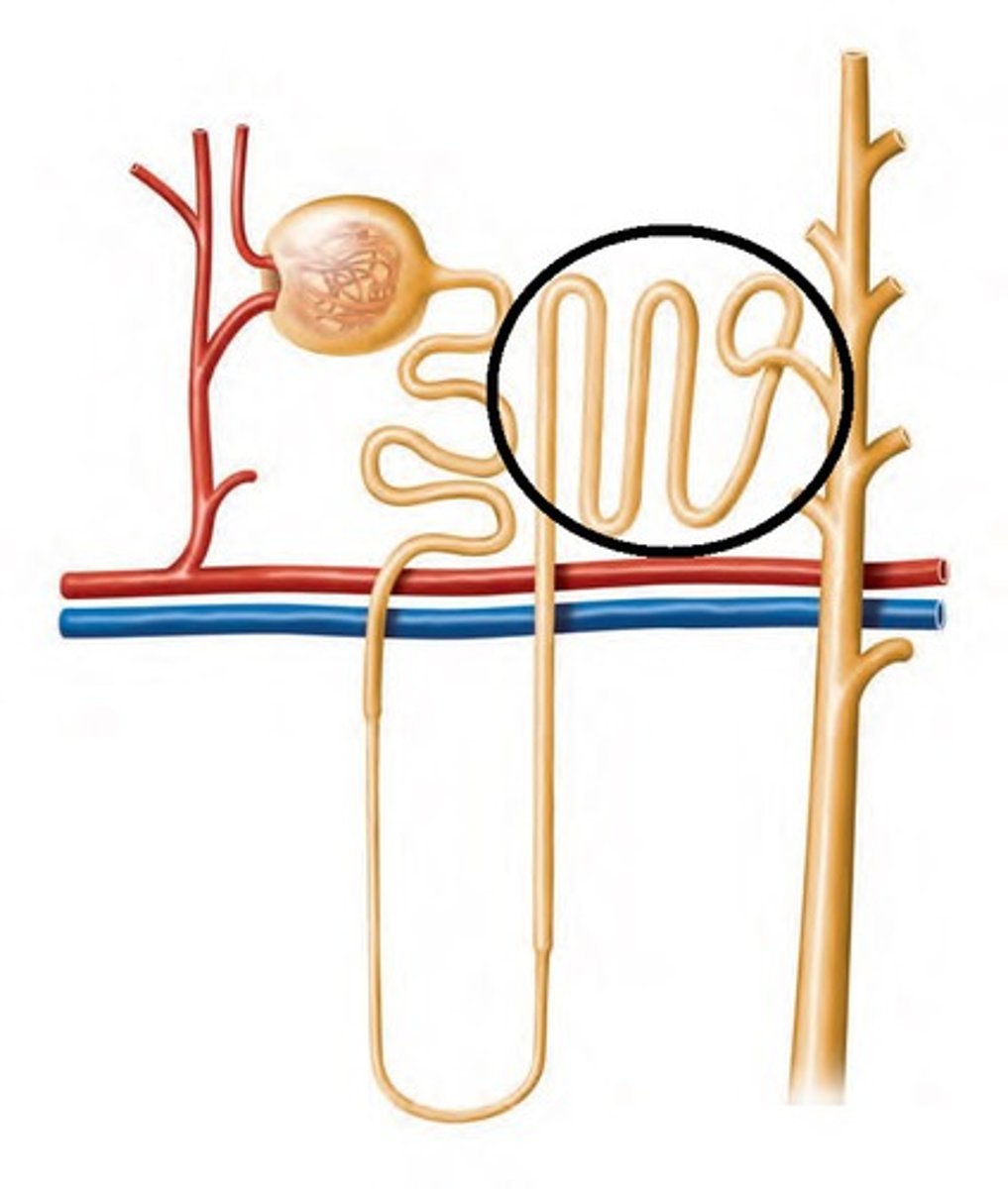
loop of henle
section of the nephron tubule that conserves water and minimizes the volume of urine
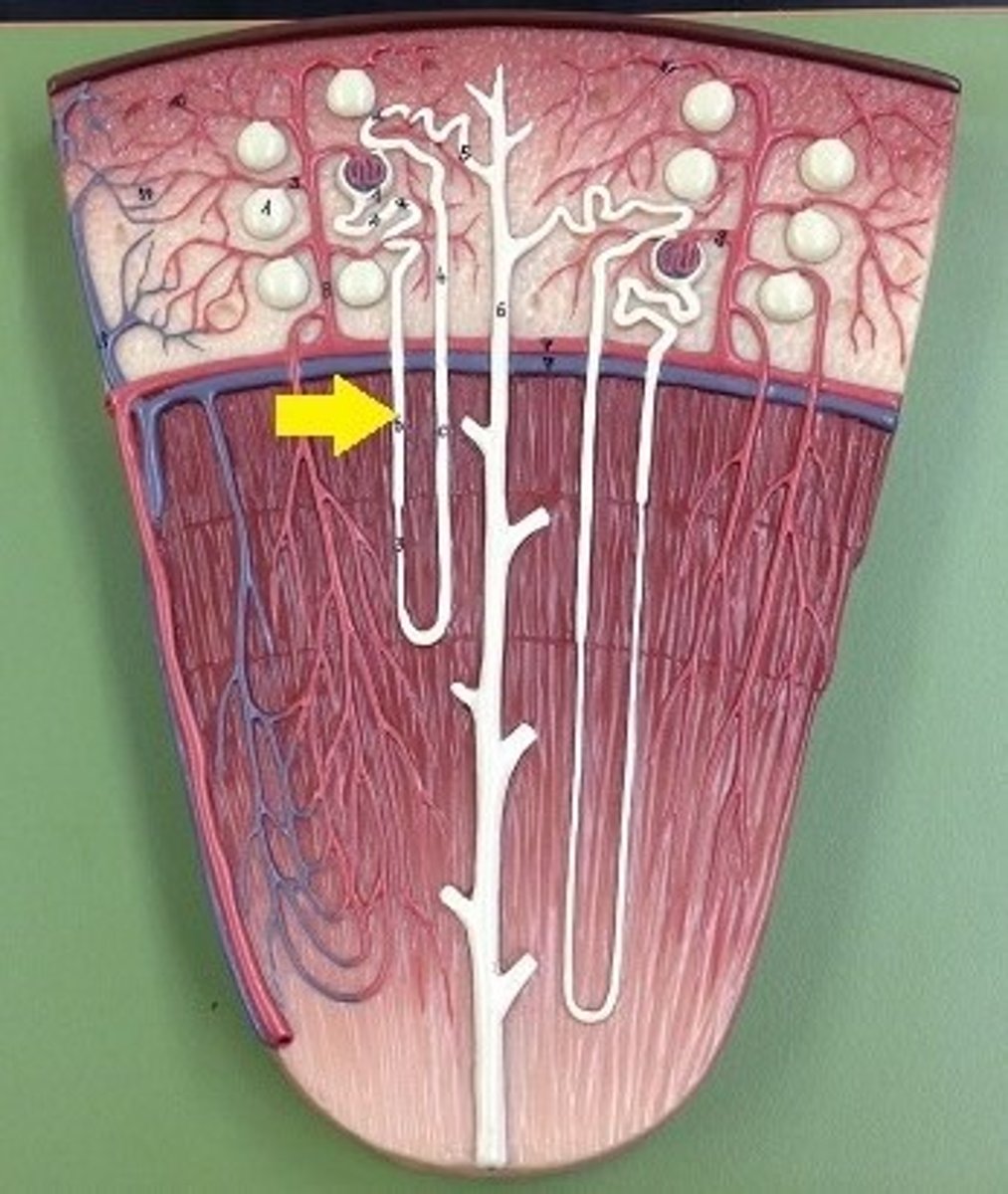
proximal convoluted tubule (PCT)
first section of the renal tubule that the blood flows through post-glomerulus; reabsorption of water, ions, and all organic nutrients
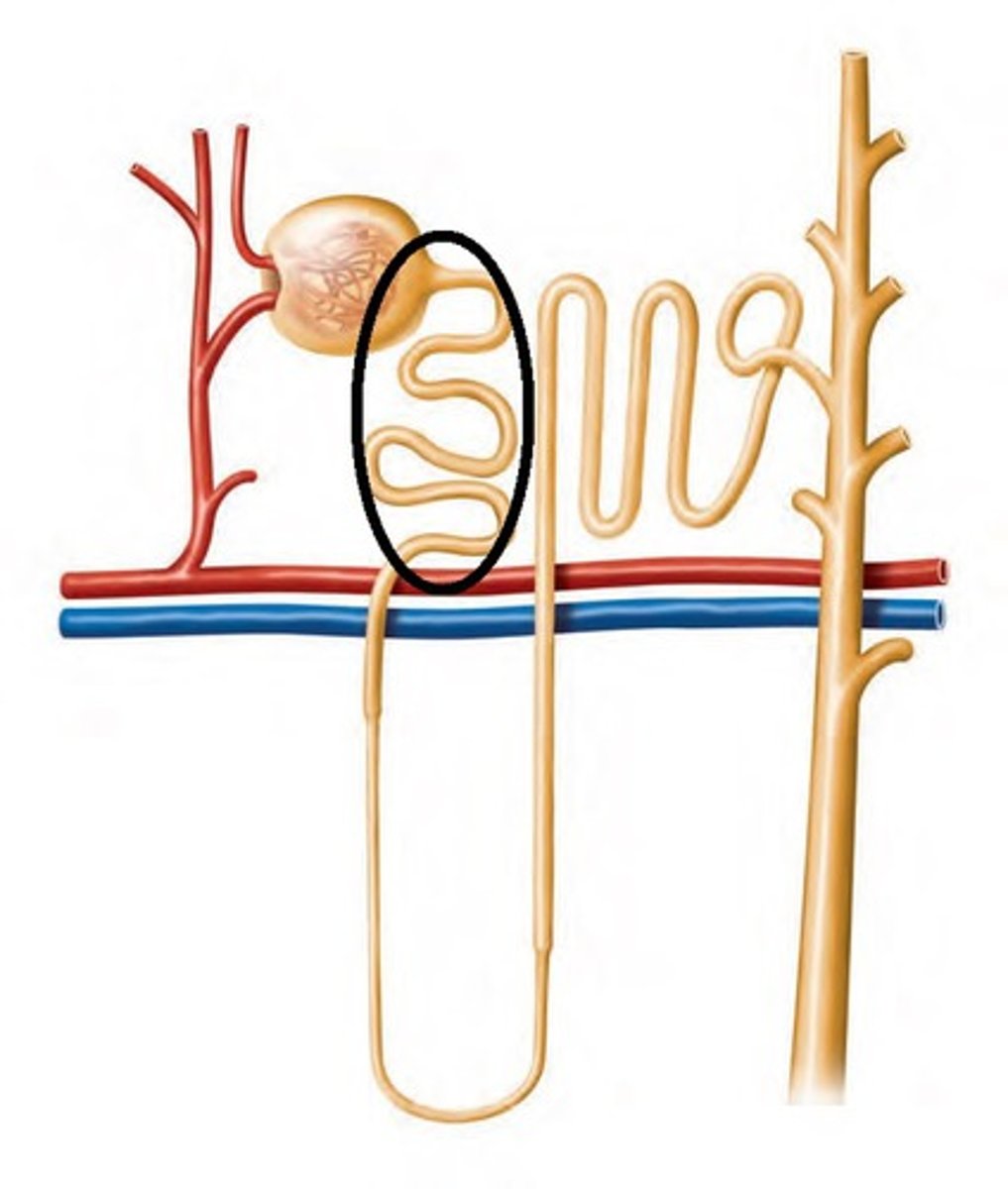
glomerulus
a ball of capillaries surrounded by Bowman's capsule in the nephron; serves as the site of filtration in the vertebrate kidney
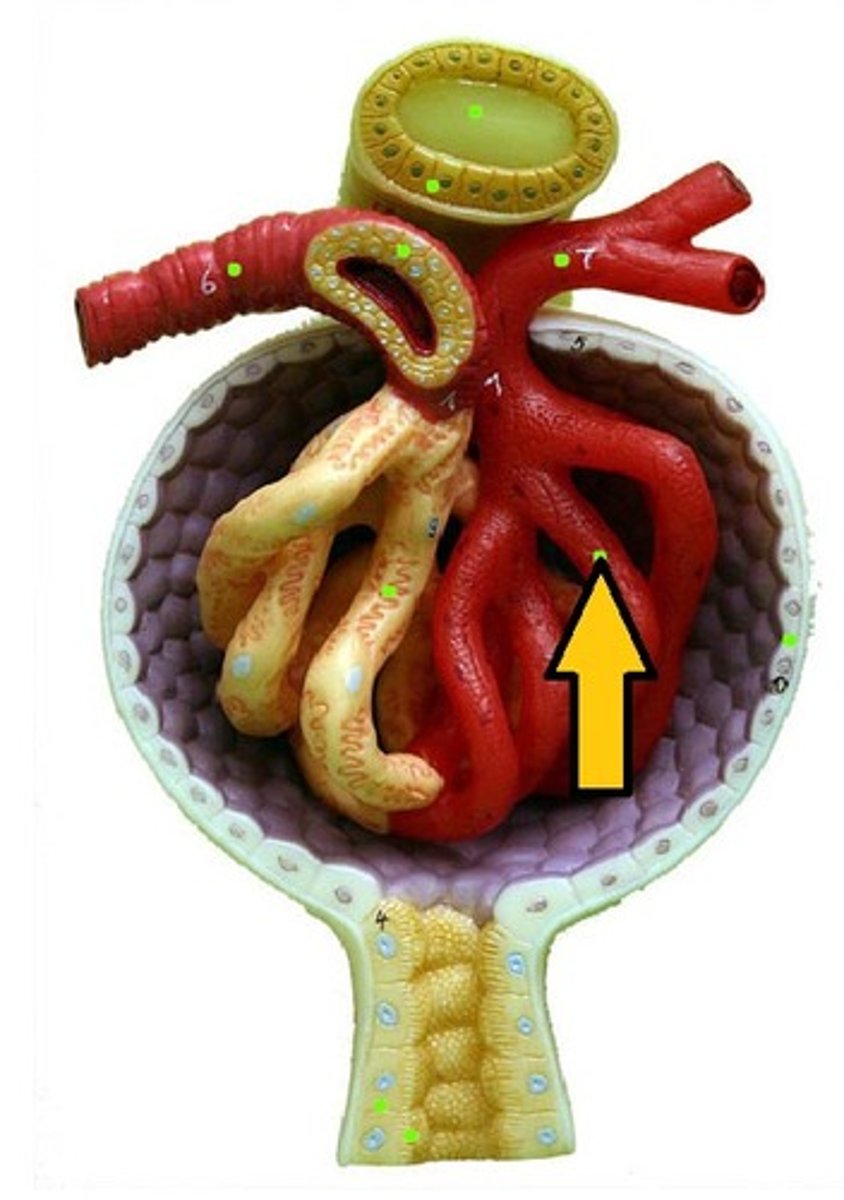
filtrate
fluid that passes from the blood through the capillary walls of the glomeruli of the kidney
pathway of filtrate through nephron (6 steps)
1. Bowman's capsule
2. proximal convoluted tubule
3. loop of henle
4. distal convoluted tubule
5. collecting duct
6. renal pelvis
how urine is formed (4 steps)
1. glomerular filtration
2. tubular reabsorption
3. tubular secretion
4. water excretion / concentration of urine
glomerular filtration
the first step in urine formation, in which filtration slits in glomerulus allow water & small ions to leave blood while retaining large molecules and cells
tubular reabsorption
second step in urine formation; occurs primarily in PCT; reclamation of valuable materials from filtrate back into bloodstream; most reabsorptio is via active transport; 60% of filtrate volume is reabsorbed
tubular secretion
third step in urine formation; nephron secretes materials into the filtrate; primarily occurs in DCT; active transport of materials like H+, K+ ions that will end up in urine
water excretion / conservation
fourth step of urine formation; dependent upon the loop of henle in mammals; kidney regulates solute concentration of blood and excretes/conserves water as needed (ex: dilute urine when hydrated, concentrated urine when dehydrated)
steps of water excretion/conservation
1. sodium moves out of the ascending loop
2. water diffuses out of descending loop
3. repeat
4. urine entering collecting duct is dilute
5. some urea diffuses out of collecting duct
6. permeability of collecting duct walls is variable depending on ADH regulation
ADH
antidiuretic hormone; increases the permeability of collecting duct walls, allowing water to pass (so less water is excreted)
helpful: this hormone is inhibited by alcohol, which is why urination is more frequent; water is unable to pass through the less-permeable collecting duct walls